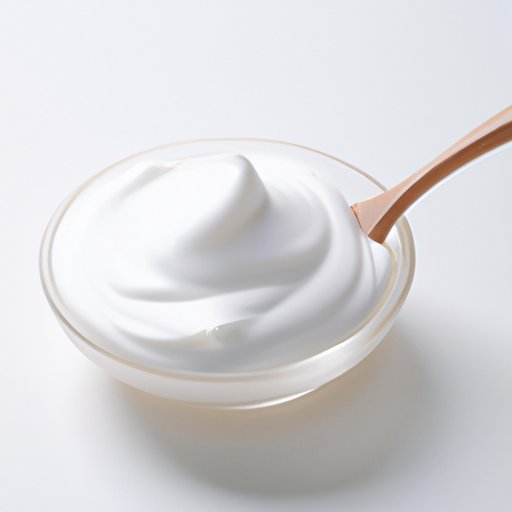Introduction
Cream is a dairy product that is widely used in cooking and baking. Its rich texture and flavor make it a go-to ingredient for many recipes. However, it is important to know the fat content of different types of cream as it can have a significant impact on the nutritional value of your dishes. In this article, we will explore the fat content of different types of cream, their nutritional values, health benefits and drawbacks, and how to cook with them.
Nutritional Values of Different Types of Cream
There are several types of cream, and each differs in its fat content and nutritional value. Here are some of the most common types of cream and their nutritional information:
Light Cream
Light cream, also known as coffee cream, contains about 20-30% fat. It has a relatively low calorie count, with around 30-40 calories per tablespoon.
Heavy Cream
Heavy cream, also known as whipping cream or double cream, contains about 35-40% fat and has a much higher calorie count than light cream, with around 50-60 calories per tablespoon. Heavy cream is ideal for creating rich, creamy sauces and desserts.
Whipped Cream
Whipped cream is made by whipping heavy cream until it becomes light and fluffy. It has a similar fat content to heavy cream and around 50-60 calories per tablespoon. However, because of the added air, whipped cream has a lower density and is lighter in texture.
Comparison with Other Dairy Products like Milk and Butter
Milk and butter are two other dairy products that are commonly used in cooking and baking. Milk has a much lower fat content than cream, with around 1-2% fat. Butter, on the other hand, has around 80% fat, making it much richer than even heavy cream. While butter is an important ingredient in many dishes, it should be used in moderation due to its high fat content.
Health Benefits and Drawbacks of Cream
Benefits of Consuming Cream
Cream is a good source of fat-soluble vitamins like A, D, E, and K, which are essential for maintaining healthy skin, eyesight, and immune function. Consuming cream in moderation can also enhance the flavor and texture of your dishes, making them more satisfying.
Drawbacks of Excessive Consumption
Excessive consumption of cream can lead to weight gain and health issues like heart disease. Cream is high in saturated fat, which can increase levels of bad cholesterol in the blood and increase the risk of heart disease. Individuals with conditions like lactose intolerance or dairy allergies should also avoid consuming cream.
Cooking with Different Types of Cream
Using Light Cream in Cooking
Light cream is an excellent ingredient for adding richness to dishes without the added calories. It can be used in recipes like creamy soups, sauces, and coffee beverages. Some popular recipes that use light cream include creamy tomato soup, Alfredo sauce, and pumpkin spice lattes. Keep in mind that light cream is lower in fat content than heavy cream, so it may not thicken sauces or soups as much as heavy cream would.
Using Heavy Cream in Cooking
Heavy cream is perfect for creating rich, creamy sauces and desserts like cheesecake and ice creams. It can also be used in savory dishes like fettuccine Alfredo or creamy mushroom soup. Heavy cream’s high fat content allows it to emulsify and thicken sauces and soups, giving them a luxurious texture.
Using Whipped Cream
Whipped cream is a popular topping for desserts like pies, cakes, and hot cocoa. It can also be used as a filling for cream puffs or mille-feuille. Whipped cream’s light and airy texture is created by incorporating air into heavy cream, making it less dense than other types of cream.
Pros and Cons of Using Cream
Pros of Using Cream
The benefits of using cream in your cooking and baking include a creamier texture, enhanced flavor, and improved mouthfeel. Cream adds richness and depth to dishes that other dairy products cannot provide.
Cons of Using Cream
The cons of using cream include the risk of weight gain and health issues like heart disease, especially if consumed in excess. Individuals with lactose intolerance or dairy allergies should also avoid consuming cream.
Nutritional Profile of Cream
Calorie and Nutritional Value of Different Types of Cream
Here is a breakdown of the nutritional information for different types of cream per tablespoon:
– Light Cream: 20-30% fat, 30-40 calories, 2 grams of carbohydrates
– Heavy Cream: 35-40% fat, 50-60 calories, 0.4 grams of carbohydrates
– Whipped Cream: 35-40% fat, 50-60 calories, 0.4 grams of carbohydrates
The Most Calorie-Dense Cream
Butter is the most calorie-dense cream, with around 100-120 calories per tablespoon. Because of its high fat content, it should be used in moderation.
Conclusion
Cream is a versatile ingredient that can add flavor, richness, and texture to your dishes. However, it is important to know the fat content of different types of cream and use them in moderation to avoid adverse health effects. Whether you are using light cream for soups or heavy cream for desserts, understanding the nutritional values and drawbacks of different types of cream can help you create delicious dishes that are also nutritious.
